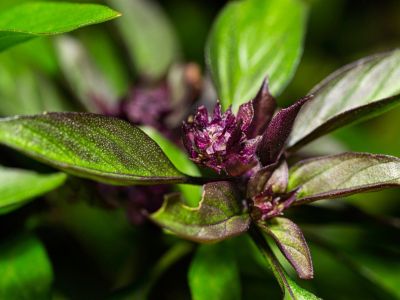About Thai Basil Plants
Thai basil (Ocimum basilicum var. thyrsiflora) is a member of the mint family and as such has a particular sweet flavor reminiscent of anise, licorice, and clove. Popular among the cuisines of Thailand, Vietnam, Laos, and Cambodia, growing Thai basil has a pleasing aroma similar to sweet basil and is generally used fresh in recipes. Also referred to as ‘Sweet Thai,’ Thai basil plants grow to a height of between 12 to 18 inches (30.5-45.5 cm.) with leaves 1 to 2 inches (2.5 to 5 cm.) long on purple stems with purple flowers. Like sweet basil, Thai basil is a perennial.
How to Plant Thai Basil
If we look at how to plant Thai basil in the home garden, our first concern is obtaining the plants. Thai basil can be purchased from the nursery or started from seed. If your choice is to purchase from the nursery, pick up a rosemary plant as well. Rosemary and Thai basil work well planted together as they enjoy similar well-drained soil, water, and fertilization. Handle the plants carefully, as they are quite delicate. Plant the new basil in a sunny area, water in, and fertilize with a nutrient-rich fish emulsion or seaweed solution two to three times during their active growing season. Sun is a key ingredient. Thai basil plants need at least six hours of direct sunlight to flourish. Water weekly but keep the water off the leaves; water from the base. Over-watering will cause the leaves to yellow and drop, and under-watering will make flowers and buds suffer, so it is important to attain a balance when watering Thai basil.
Harvesting Thai Basil
When harvesting Thai basil, remember to be gentle as the leaves bruise easily and you don’t want that to happen until you are going to use them. Harvest the leaves in the morning when their essential oils are at their peak and the flavor of the growing Thai basil will be at a premium. Also, water the Thai basil prior to harvest to intensify the flavor. Growing Thai basil tends to be more compact than other types of basil, so harvest at the top of a group of leaves; otherwise, the stem will rot. If you make a mistake, cut the stem all the way back to the next set of leaves. Unless, you are growing Thai basil as an ornamental, cut the flower off several days before harvest so the plant can focus all its energy on the leaves. When you harvest your growing Thai basil plant, take it down to about 6 inches (15 cm.).
Thai Basil Uses
Now that you have harvested the basil, what are you going to do with it? Some Thai basil uses are to infuse with vinegar or oil, to flavor Pho with mint and chilies, make tea, or pair with almost any chicken, pork, or beef dish. Recipes online include one for making Thai basil beer and a recipe for Thai basil pesto with peanuts, rice vinegar, fish sauce, and sesame oil, which will keep in the refrigerator for a week. Yum! Thai basil is usually used fresh, preferably soon after harvesting, but you can also chop it up or run it through a food processor and freeze it in ice cube trays. Once frozen, remove from the tray and store in resealable bags in the freezer for up to two months. Thai basil may also be used as an aromatherapy treatment by bruising the leaves and inhaling their aroma. They can also be bruised and rubbed beneath the eyes and on the forehead for a relaxing reprieve from a long, stressful day.
